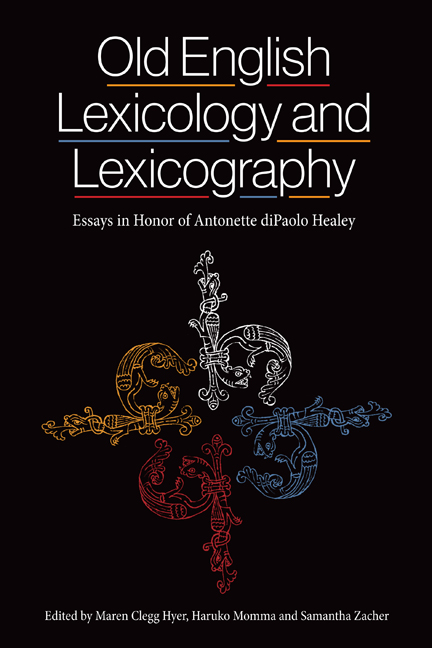Book contents
- Frontmatter
- Dedication
- Contents
- List of Illustrations
- List of Contributors
- Acknowledgements
- Abbreviations
- Introduction
- I Old English Poets and their Word-Craft
- 1 Beowulf and the Art of Invention
- 2 Juliana 53a Revisited (hætsð hæþenweoh)
- 3 Wounds and Compensation in the Old English Soul and Body Poems
- II Old English Homiletic Tradition
- 4 Defining and Redefining: Ælfric's Access to Gregory's Homiliae in Evangelia in the Composition of the Catholic Homilies
- 5 Lambeth Homily 4 and the Textual Tradition of the Visio Pauli
- 6 ‘A Vision of Souls’: Charity, Judgment, and the Utility of the Old English Vision of St. Paul
- 7 The Vocabulary of Sin and the Eight Cardinal Sins
- III Anglo-Saxon Institutions
- 8 The King (and Queen) and ‘I’: Self-Construction in Some Anglo-Saxon Royal Documents
- 9 Anglo-Saxon Maccabees: Political Theology in Ælfric's Lives of Saints
- 10 Nunne in Early Old English: Misogyny in its Literary Context
- IV Lexis of the Quotidian
- 11 Cingulum est custodiam: Semiotics and the Semantic Range of gyrdels
- 12 Island Time: The English Day and the Christian Hours
- 13 ‘Revising Hell’: The Voices of Teachers in Anglo-Saxon Studies and Anglo-Saxon England
- V The Task of the Lexicographer
- 14 Cryptography and the Lexicographer: Codifying the Code
- 15 Genre and the Dictionary of Old English
- Epilogue: Word-Hord
- 16 Reading Beowulf with Isidore's Etymologies
- An Old English Lexicon Dedicated to Toni Healey
- Toni Healey: A Tribute
- List of publications of Antonette diPaolo Healey
- Index
- Tabula Gratulatoria
- Miscellaneous Endmatter
- Anglo-Saxon Studies
4 - Defining and Redefining: Ælfric's Access to Gregory's Homiliae in Evangelia in the Composition of the Catholic Homilies
Published online by Cambridge University Press: 17 September 2020
- Frontmatter
- Dedication
- Contents
- List of Illustrations
- List of Contributors
- Acknowledgements
- Abbreviations
- Introduction
- I Old English Poets and their Word-Craft
- 1 Beowulf and the Art of Invention
- 2 Juliana 53a Revisited (hætsð hæþenweoh)
- 3 Wounds and Compensation in the Old English Soul and Body Poems
- II Old English Homiletic Tradition
- 4 Defining and Redefining: Ælfric's Access to Gregory's Homiliae in Evangelia in the Composition of the Catholic Homilies
- 5 Lambeth Homily 4 and the Textual Tradition of the Visio Pauli
- 6 ‘A Vision of Souls’: Charity, Judgment, and the Utility of the Old English Vision of St. Paul
- 7 The Vocabulary of Sin and the Eight Cardinal Sins
- III Anglo-Saxon Institutions
- 8 The King (and Queen) and ‘I’: Self-Construction in Some Anglo-Saxon Royal Documents
- 9 Anglo-Saxon Maccabees: Political Theology in Ælfric's Lives of Saints
- 10 Nunne in Early Old English: Misogyny in its Literary Context
- IV Lexis of the Quotidian
- 11 Cingulum est custodiam: Semiotics and the Semantic Range of gyrdels
- 12 Island Time: The English Day and the Christian Hours
- 13 ‘Revising Hell’: The Voices of Teachers in Anglo-Saxon Studies and Anglo-Saxon England
- V The Task of the Lexicographer
- 14 Cryptography and the Lexicographer: Codifying the Code
- 15 Genre and the Dictionary of Old English
- Epilogue: Word-Hord
- 16 Reading Beowulf with Isidore's Etymologies
- An Old English Lexicon Dedicated to Toni Healey
- Toni Healey: A Tribute
- List of publications of Antonette diPaolo Healey
- Index
- Tabula Gratulatoria
- Miscellaneous Endmatter
- Anglo-Saxon Studies
Summary
Ælfric's substantial corpus is characterized by insistent acts of self-definition, found in prefaces, codas, explanatory asides, careful acknowledgement of the traditions to which his writings belong, and recurring references to senior ecclesiastics and secular patrons, with whose authority he thereby associates himself. These acts of self-definition served his polemical purpose in carrying forward the aims of the Benedictine Reform. They were put to use from the start, in his first major works, the two series of Catholic Homilies, issued respectively in 989 and 994. Here, where the tenets of the faith and the interpretation of the Bible were at stake, the dominant tactic was the naming of his orthodox authorities. It is the names of the Church Fathers that occur in the homilies themselves; but when he sent a copy of the First Series to Archbishop Sigeric, Ælfric took his self-definition a stage further. Here, in a covering Latin letter to an ecclesiastical superior within the Reform tradition, he not only named the major patristic authorities on which he drew, but he also specified two of the Carolingian transmitters of that orthodox tradition, Smaragdus and Haymo. In this professional context, such additional information served to define Ælfric more precisely as a man who was drawing upon works which, in Reform circles, were among the accepted and authoritative textual transmitters of the tradition which they wished to promote.
This sharper definition places Ælfric within a layered tradition which requires us to engage – as he did – with the intertextual relationship between ultimate and immediate sources: in other words, the patristic words upon which he drew, and the mediated form in which he had access to them. His thoroughgoing commitment to the patristic tradition in the Catholic Homilies, which he so carefully highlighted, has been extensively confirmed by modern source-study, and it has been shown that, in terms of practical access to this material, he relied heavily on the Carolingian homiliaries of Paul the Deacon, Smaragdus, and Haymo, where not only was the patristic exegesis conveniently allotted to the days of the liturgical year, but also, in the case of the homiliaries of Paul and Smaragdus, was ascribed to their original authors, by the rubrics in the case of Paul's homiliary, and by marginal annotations in the homiliary of Smaragdus.
- Type
- Chapter
- Information
- Old English Lexicology and LexicographyEssays in Honor of Antonette diPaolo Healey, pp. 67 - 79Publisher: Boydell & BrewerPrint publication year: 2020



